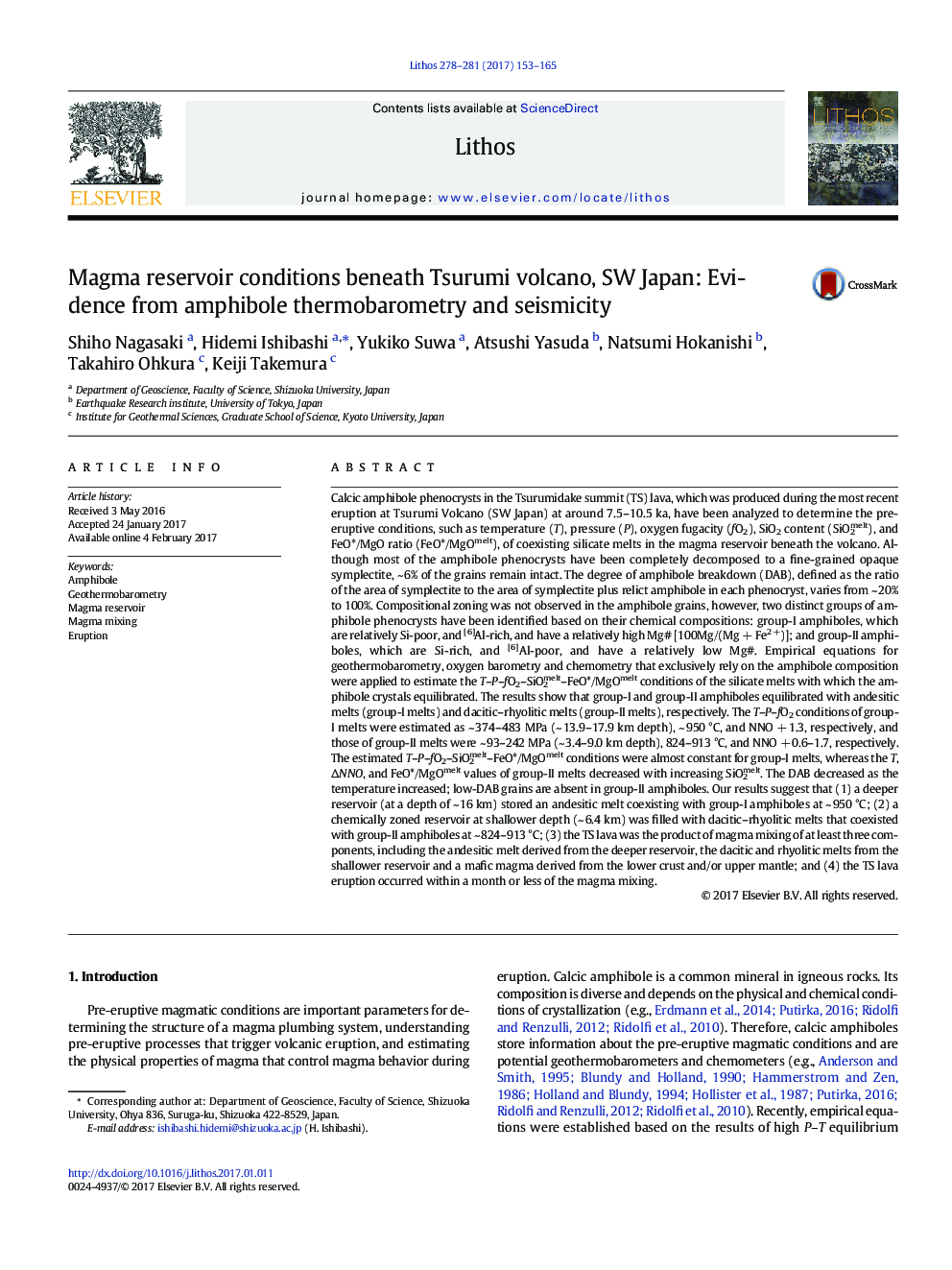| کد مقاله | کد نشریه | سال انتشار | مقاله انگلیسی | نسخه تمام متن |
|---|---|---|---|---|
| 5784161 | 1638632 | 2017 | 13 صفحه PDF | دانلود رایگان |

- Deeper and shallower magma reservoirs existed at depths of ca. 16Â km and 6.4Â km.
- The depths of the reservoirs are consistent with seismicity of the study area.
- Andesitic and dacitic-rhyolitic melts are respectively stored in the deeper and shallower reservoirs.
- At least three magmatic components were mixed to form the TS lava.
- The lava eruption occurred within a month or less of the magma mixing.
Calcic amphibole phenocrysts in the Tsurumidake summit (TS) lava, which was produced during the most recent eruption at Tsurumi Volcano (SW Japan) at around 7.5-10.5 ka, have been analyzed to determine the pre-eruptive conditions, such as temperature (T), pressure (P), oxygen fugacity (fO2), SiO2 content (SiO2melt), and FeO*/MgO ratio (FeO*/MgOmelt), of coexisting silicate melts in the magma reservoir beneath the volcano. Although most of the amphibole phenocrysts have been completely decomposed to a fine-grained opaque symplectite, ~ 6% of the grains remain intact. The degree of amphibole breakdown (DAB), defined as the ratio of the area of symplectite to the area of symplectite plus relict amphibole in each phenocryst, varies from ~ 20% to 100%. Compositional zoning was not observed in the amphibole grains, however, two distinct groups of amphibole phenocrysts have been identified based on their chemical compositions: group-I amphiboles, which are relatively Si-poor, and [6]Al-rich, and have a relatively high Mg# [100Mg/(Mg + Fe2 +)]; and group-II amphiboles, which are Si-rich, and [6]Al-poor, and have a relatively low Mg#. Empirical equations for geothermobarometry, oxygen barometry and chemometry that exclusively rely on the amphibole composition were applied to estimate the T-P-fO2-SiO2melt-FeO*/MgOmelt conditions of the silicate melts with which the amphibole crystals equilibrated. The results show that group-I and group-II amphiboles equilibrated with andesitic melts (group-I melts) and dacitic-rhyolitic melts (group-II melts), respectively. The T-P-fO2 conditions of group-I melts were estimated as ~ 374-483 MPa (~ 13.9-17.9 km depth), ~ 950 °C, and NNO + 1.3, respectively, and those of group-II melts were ~ 93-242 MPa (~ 3.4-9.0 km depth), 824-913 °C, and NNO + 0.6-1.7, respectively. The estimated T-P-fO2-SiO2melt-FeO*/MgOmelt conditions were almost constant for group-I melts, whereas the T, ÎNNO, and FeO*/MgOmelt values of group-II melts decreased with increasing SiO2melt. The DAB decreased as the temperature increased; low-DAB grains are absent in group-II amphiboles. Our results suggest that (1) a deeper reservoir (at a depth of ~ 16 km) stored an andesitic melt coexisting with group-I amphiboles at ~ 950 °C; (2) a chemically zoned reservoir at shallower depth (~ 6.4 km) was filled with dacitic-rhyolitic melts that coexisted with group-II amphiboles at ~ 824-913 °C; (3) the TS lava was the product of magma mixing of at least three components, including the andesitic melt derived from the deeper reservoir, the dacitic and rhyolitic melts from the shallower reservoir and a mafic magma derived from the lower crust and/or upper mantle; and (4) the TS lava eruption occurred within a month or less of the magma mixing.
Journal: Lithos - Volumes 278â281, May 2017, Pages 153-165